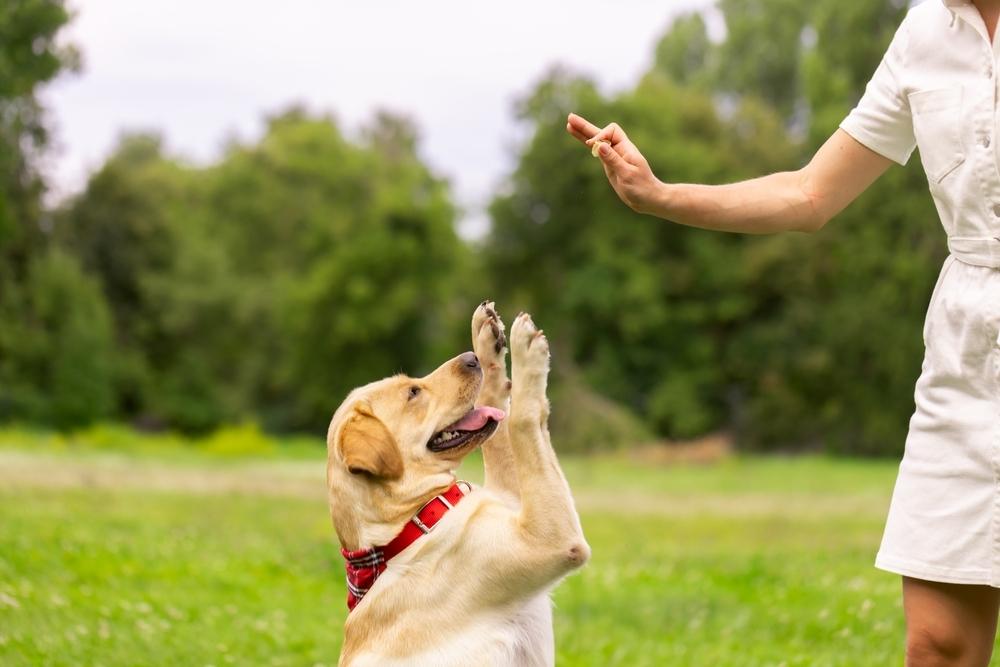

There are few things better than the feeling of giving your puppy a delicious treat. Treating your puppy can offer many benefits, including facilitating training and deepening the human-animal bond. Too many treats for a puppy, however, can eventually result in unhealthy weight gain, picky eating behaviors and malnutrition.
So, when can you give a puppy treats? While you want to avoid rewarding them too often, treating your pup can be beneficial in certain contexts. Discover the best practices for giving your puppy treats and help create healthy habits that last a lifetime.
Can Puppies Have Treats?
One of the most common questions puppy parents have is when they can start adding treats into their puppy's routine. In general, you can introduce appropriately formulated treats to your puppy when they're around 8 weeks old.

What Treats Can I Give My Puppy?
When choosing treats for a puppy, select age-appropriate formulas that align with a puppy's nutritional needs. Young puppies are growing quickly, and they need every calorie to count. Prioritize small treats packed with protein over treats high in calories or carbohydrates. Because your puppy's developing teeth and gums are sensitive, you'll also want to select treats that are soft and easy to chew.
What Are the Best Puppy Treats for an 8-Week-Old Puppy?
Most veterinarians and other experts suggest waiting until a puppy is 8 weeks old to start offering treats. The best treats for an 8-week-old puppy should be soft, bite-sized, low in calories and high in protein. However, it's always best to consult your vet when selecting treats and puppy food. They can help you choose the most suitable options depending on your puppy's specific needs.
Moderation and Portion Control
As a general rule of thumb, treats shouldn't make up more than 10% of your dog's daily calorie requirement.
For example, if your puppy needs to eat 200 calories per day, they should get no more than 20 calories in treats daily. This rule can be especially hard to follow if your dog is very small or you're using treats for training. To help stay within your puppy's daily calorie limit and honor the 10% treat rule, you can reserve part of their daily kibble amount, hand-feeding them their regular food in the form of treats.
While it may feel challenging to follow, the 10% rule is an important guideline to avoid overfeeding, obesity, abnormal growth and nutritional imbalances. Complete and balanced nutrition for puppies should be the cornerstone of your pup's daily intake. Growing puppies have specific nutritional requirements that differ from adult dogs, and puppy foods are specially formulated to meet the needs of growing puppies. Avoid overfeeding treats so your puppy has the best opportunity to grow into a healthy adult.
How to Use Treats for Training
Puppy training can be a whole lot easier when using treats as positive reinforcement. However, if you always use treats to train, you can create an over-reliance on treat training and an expectation from your puppy that good behavior always equals a tasty treat. To avoid this reliance and set your puppy up for training success, consider the following guidelines:
Use continuous reinforcement initially. Only reward your puppy with a treat each time they perform a desired behavior when they're first learning that behavior.
Gradually transition to intermittent treating. While continuous reinforcement is key to forming an association between behavior and reward in your puppy's mind, gradually decrease treat frequency as they reliably perform the behavior (known as intermittent treating).
Choose quick-to-eat treats. When first training a behavior, use a treat your puppy can easily and quickly chew and swallow so they don't get distracted by chewing. The best puppy training treats are soft, small, delicious and gulpable.
Keep house-training treats exclusive. If you're using treats to house train your puppy, use those treats for house training and nothing else. This makes the treats extra special and will help motivate your puppy to do their business in the approved place.
Train before mealtime for motivation. Schedule puppy training sessions before mealtime when they're hungry and naturally motivated by food. To avoid overfeeding, try using a piece of kibble from their daily allotment in place of a treat.

Bear in mind that not all puppies are food-motivated. Some dogs learn better with different rewards, like praise, pets or play. You can also train a puppy with clicker training, a method that can significantly reduce reliance on treats over time. You begin clicker training by loading the clicker with a treat. This creates an association between the click and the treat, which a puppy receives to reinforce desired behavior. Eventually, the puppy will make an association between the desired behavior and the click rather than the treat, allowing you to move away from treats being the primary reinforcer for desired behavior.
Unacceptable Treats for a Puppy: What to Avoid
To avoid upset stomachs or more serious problems, vets generally recommend offering puppies (and adult dogs) dog-specific treats. Yes, it can be tempting to share the food on your plate with your dog when they look at you with those adorable, begging eyes. However, this is discouraged for several important reasons, including:
You're teaching them to beg or steal food, which can be a problem down the road.
Many human foods can cause health problems in dogs, such as grapes, garlic and xylitol.
Puppies can develop picky appetites, which can make them adverse to appropriately formulated and balanced foods.
Sharing people food can lead to unhealthy weight gain, a risk factor for various health conditions.
When in doubt about what's considered a healthy and safe treat for your puppy, ask your vet.
Treating Your Puppy With Care
Can puppies have treats? Yes, but it's important to choose treats that are appropriate for their age and size, offer them in moderation to help prevent unhealthy weight gain and avoid humans foods that can upset their young stomachs.
Remember: When it comes to training treats, opt for small, soft and easily swallowed formulas designed with puppies' nutritional needs in mind. In the hands of savvy pet parents, treats can be a part of a puppy pathway that leads to a lifetime of health and happiness. So, be smart with your treat tactics, consult your vet for support and, most of all, enjoy the journey!



















